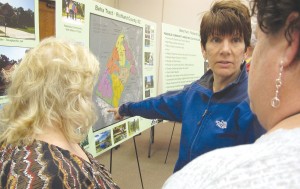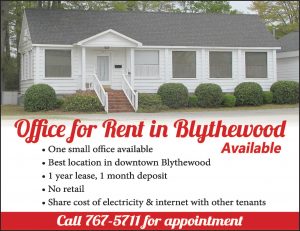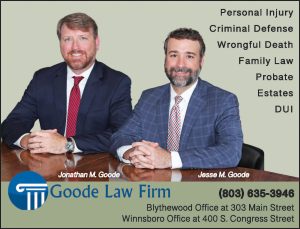
At a community meeting last week at The Manor, Heins Road resident Laurie Rossdentsher discusses with neighbors a map of a proposed residential development that they fear could adversely affect the tranquility of their rural properties. (Photo/Barbara Ball)
BLYTHEWOOD – About 75 Blythewood rural property owners attended a community meeting Oct. 1 at The Manor in Blythewood to get answers to their questions about a mega housing development proposed on 202 acres off Heins Road near their homes.
Even though the developer’s team was there to answer their questions, the property owners left two hours later without the primary piece of information they came for – specifically, how many homes the developer planned for the development.
The meeting was hosted by Blythewood Mayor J. Michael Ross and facilitated by the area’s representative on Richland County Council, Councilwoman Joyce Dickerson. House Rep. Joseph McEachern, who represents the area, also attended.
Near the end of Thursday night’s meeting, McEachern weighed in on the side of the audience, telling them at one point, “This is just a proposed plan they (the developers) have. They don’t have to do this (re-zoning). If (Council) gives them this zoning, their proposal could change. Is that right?” McEachern asked, turning to Columbia attorney Robert Fuller who is representing the developer, Drapac, Inc., an Australian based real estate investment and development company.
“That’s right,” Fuller answered.
“I think you’re being short changed,” McEachern told the audience, “to be asked to support something you don’t have the numbers for. I would be adamant against supporting this (project) without this question being answered. I’m not sure I ever came to a meeting to discuss zoning when the (developer) didn’t have the numbers,” said McEachern who served as the County Council representative for the area before being elected to the House.
Drapac, Inc. has the 202 acres under contract contingent upon the rezoning of the property. The company has applied to Richland County to have the parcel rezoned from Rural (RU) zoning that would ordinarily permit about 267 homes on lots no smaller than .75-acres to Residential Estate (RS-E) zoning that could allow as many as 529 homes on lots as small as .30- or .25-acres (see box.)
“I don’t see where I am going to raise my hand to approve 500 homes,” Dickerson assured the crowd in her opening comments, referring to how she might vote on the matter. “However,” she continued, “I will be willing for you all to come together and find a compromise and see what we can do and work together to get the most out of the property for the community and for the developer.”
Joel Tew, a spokesperson for Michael Drapac, who owns the company and opened a U. S. headquarters in Atlanta three years ago, told the audience, “We aren’t trying to change the zoning because we want to build more houses. We want to change it so we can build something special. That’s the only reason we want to change the zoning.”
Asked by members of the audience if Drapac, who remained in Melbourne, Australia on business, would be content with 250 homes on the property, Tew answered, “No. Based on our preliminary analysis, we do not believe the project is economically feasible at 250 homes.”
Fuller further told the audience, “What you may not like to hear is that under the current RU zoning, by utilizing the land development regulations and the open space design standards now allowed by the County, the developer could build 334 homes right now without asking for a zoning change.”
Asked if the developer would be content with building that number (334) of homes, Fuller answered, “No.” Asked about holding the number of homes to 350, the answer was still, “No.”
“Drapac is looking for something between 334 and 500 homes that the community can live with, the County can approve and that we can make work financially,” Tew explained. But, he added, “We don’t have that silver number yet. Michael’s philosophy is that everyone in business has to have a reasonable return on their investment. That’s the rules, and there’s nothing wrong with that. He doesn’t apologize for being in business, for making a profit and a fair return for his investors,” Tew told the audience.
Fuller told the residents, “The (Richland County planning) staff has already agreed that RS-E zoning would be the appropriate way to develop the property to get the most planning into the development and maximize the opportunities for the Beha family (who owns the property) and the community as a whole.”
He also pointed out that the Planning Commission recommended the requested RS-E zoning to County Council with a 6-3 vote and that RS-E zoning complies with the Comprehensive Land Use Plan (adopted by the County Council last year) for the area.
There was criticism from the audience that the Planning Commission vote and recommendation took place during the middle of a work day when most of the people who live in the area of the proposed development had to be at work.
“You say you want to build a better community,” one unidentified resident said. “You’re talking to homeowners, not home buyers. We feel we have that community here in Blythewood already.”
After an extended applause of support for the speaker, Tew countered, “Before you were a homeowner, you, too, were a home buyer.”
“But we didn’t ask for a zoning change when we moved out here,” the speaker answered.
Residents also had questions about the effect of additional traffic the proposed development would produce. Resident Carol Ward questioned the traffic study on record for Heins Road. Planning Commissioners, at their Sept. 8 meeting, referenced a County staff report, based on a 2009 traffic study, stating that Heins Road operates at a low level of traffic, only 600 cars per day. Ward said Commissioners were asked if the traffic study could be extended further out to reflect current traffic on Langford Road that bottlenecks as it travels into Blythewood during heavy traffic hours.
“(The Planning Commissioners) said they are only required to look at the traffic on Heins Road and that Heins Road could accommodate the increased traffic,” Ward said.
Tew answered that the traffic study would, indeed, include more than Heins Road and that Drapac would adhere to the requirements of any such traffic study. But Dickerson pointed out that a traffic study for the area would not be done until the rezoning request is finalized.
McEachern told residents that they had a legitimate concern about the traffic on Langford Road.
“I can’t give you much comfort about roads,” McEachern said regarding improvements to be paid for by the state. “We haven’t even been able to get Blythewood Road taken care of.”
Lorraine Abell, who lives not far from the proposed development, addressed other areas she said would be adversely affected by that development and others it might spawn in the area – the need for more schools, which would bring higher taxes, the need for more law enforcement and an increase in the crime rate.
“These weren’t even discussed,” Abell said. “We wouldn’t have even been here tonight if we had been given more information before we got to this point.” She also pointed out the irony of a slogan written on the wall in the Council chambers – Uniquely Rural. “I think we’re losing that.”
Early in the meeting, Fuller told the audience, “We are here tonight to tell you that, at the end of the day, we will tell you what we do intend to do.”
But it was not to be at the end of that day.
Before adjourning the meeting, Dickerson told the developer’s team that she wanted them to get back to her with a final number of homes very soon so she could schedule another meeting with the residents and relay that information to them before Oct. 27, when the public hearing and the first of three votes by County Council would take place in Council’s chambers.
That meeting will be the only time residents will be allowed to address County Council about their concerns over the rezoning.











